Submitted:
04 January 2024
Posted:
08 January 2024
You are already at the latest version
Abstract
Keywords:
1. Introduction
2. Materials and Methods
2.1. Materials
2.2. Mechanical joining process
3. Results and Discussion
3.1. Joint forming process and interlock parameters
3.2. Rivet and sheet deviations
3.3. Strength and failure mechanism of the CR joint
4. Conclusions
- As the depth of the die (hd) increased, the maximum value of the forming force decreased. The relation was observed for each of the analysed offset values. Increasing the depth of insertion of the rivet (of) results in an increase in the force required to form the joint.
- The smaller the die depth (hd) used, the greater the maximum shear force obtained in the lap joint. The load capacity of the “CR” joint was increased by increasing the offset value (of). However, using a larger offset required greater forming force, and the process was more energy consuming.
- For all analysed cases of using the depth of the die (hd), there was a relation that with an increase in the insertion depth of, both the external height of the embossment and the largest rivet diameter d1 increased. Joints made using a die with a depth of hd=1.45 [mm] were characterized by the largest embossment dimensions.
- The higher the value of the rivet offset (of), the more the rivet flows plastically in the direction transverse to the movement of the punch. The deeper the die used, the radial flow of the rivet in its lower part decreased and the flow increased in the direction consistent with the displacement of the punch. For all three die depths hd=1.45, 1.60 and 1.75 [mm], the value of the interlock parameter increased with the increase of the offset value (of). The maximum value of the parameter tu characterized joints made with hd=1.60 [mm] and of =0.60 [mm].
- Up to the displacement range of =0.2 [mm], the highest stiffness was obtained for joints formed with a depth of the die hd =1.60 [mm]. Despite increasing the depth of the die to 1.75 [mm] (the rivet is pressed deeper in the joined material), greater joint stiffness was not achieved. In only one case in the range s from 0.3 to 0.5 [mm], for joints formed with a die of hd=1.75 [mm] depth, the stiffness of the joints was the highest.
- The analysis of the deformation of the sheet metal surface in the area of the joint showed that for each value of the of, the upper plane of the rivet in the joint is below the given value (measured in relation to the nominal model). As the offset increases, the deformation of the sheets and the position of the upper surface of the rivet changes. The highest deviations of the sheets occurred for a formed joint with of=0.6 [mm] and with a depth of the die hd=1.45 [mm].
Author Contributions
Funding
Institutional Review Board Statement
Informed Consent Statement
Data Availability Statement
Conflicts of Interest
References
- Heeren, R;, Timmermann, R. Mechanical Joining in the Automotive Industry. 2002, SMWC X, Paper No. 4-1.
- Zhou, Y.; Lan, F.; Chen, J. Influence of tooling geometric parameters on clinching joint properties for steel-aluminum car-body structures. In Proceedings of the 3rd IEEE International Conference on Computer Science and Information Technology, ICCSIT, Chengdu, China, 7–10 July 2010; IEEE. [Google Scholar]
- Mucha, J.; Witkowski, W. The experimental analysis of the double joint type change effect on the joint destruction process in uniaxial shearing test. Thin-Wall. Struct. 2013, 66, 39–49. [Google Scholar] [CrossRef]
- Saberi, S.; Enzinger, N.; Vallant, R.; et al. Influence of plastic anisotropy on the mechanical behavior of clinched joint of different coated thin steel sheets. Int. J. Mater. Form. 2008, 1, 273–276. [Google Scholar] [CrossRef]
- Mucha, J.; Kaščák, L.; Spišák, E. Joining the car-body sheets using clinching process with various thickness and mechanical property arrangements. Arch. Civ. Mech. Eng. 2011, 1, 135–148. [Google Scholar] [CrossRef]
- Zhang, X.; Chen, C.; Peng, H. Recent development of clinching tools and machines. Int. J. Adv. Manuf. Technol. 2022, 121, 2867–2899. [Google Scholar] [CrossRef]
- Džupon, M.; Kaščák, Ľ.; Cmorej, D.; Čiripová, L.; Mucha, J.; Spišák, E. Clinching of high-strength steel sheets with local preheating. Appl. Sci. 2023, 13, 7790. [Google Scholar] [CrossRef]
- Zhang, Y.; Wang, C.; Shan, H.; Li, Y.; Luo, Z. High-toughness joining of aluminum alloy 5754 and DQSK steel using hybrid clinching–welding process. J. Mater. Process. Technol. 2018, 259, 33–44. [Google Scholar] [CrossRef]
- Lee, C.-J.; Shen, G.; Kim, B.-M.; Lambiase, F.; Ko, D.-C. Analysis of failure-mode dependent joint strength in hole clinching from the aspects of geometrical interlocking parameters. Metals 2018, 8, 1020. [Google Scholar] [CrossRef]
- He, X.; Pearson, I.; Young, K. Self-pierce riveting for sheet materials: state of the art. J. Mater. Process. Technol. 2008, 199, 27–36. [Google Scholar] [CrossRef]
- Ang, H.Q. An overview of self-piercing riveting process with focus on joint failures, Corrosion issues and optimisation techniques. Chin. J. Mech. Eng. 2021, 34, 1–25. [Google Scholar] [CrossRef]
- Xing, B.; He, X.; Zeng, K.; et al. Mechanical properties of self-piercing riveted joints in aluminum alloy 5052. Int. J. Adv. Manuf. Technol. 2014, 75, 351–361. [Google Scholar] [CrossRef]
- Zhang, X.; He, X.; Gu, F.; Ball, A. Self-piercing riveting of aluminium–lithium alloy sheet materials. J. Mater. Process. Technol. 2019, 268, 192–200. [Google Scholar] [CrossRef]
- Zhao, L.; He, X.; Xing, B.; Zhang, X.; Cheng, Q.; Gu, F.; Ball, A. Fretting behavior of self-piercing riveted joints in titanium sheet materials. J. Mater. Process. Technol. 2017, 249, 246–254. [Google Scholar] [CrossRef]
- He, X.; Wang, Y.; Lu, Y.; et al. Self-piercing riveting of similar and dissimilar titanium sheet materials. Int. J. Adv. Manuf. Technol. 2015, 80, 2105–2115. [Google Scholar] [CrossRef]
- Available online: https://global.abb (accessed on 30 November 2023).
- Heyser, P.; Wiesenmayer, S.; Frey, P.; et al. Consideration of the manufacturing history of sheet metal components for the adaptation of a clinching process. Proc. Inst. Mech. Eng. L: J. Mater.: Des. Appl. 2022, 236, 1203–1215. [Google Scholar] [CrossRef]
- Chen, C.; Zhang, X.; Wen, C.; Yin, Y. Effect of blank holder force on joining quality of the flat clinch-rivet process. Int. J. Adv. Manuf. Technol. 2022, 121, 6315–6323. [Google Scholar] [CrossRef]
- Kaščák, L.; Spišák, E.; Mucha, J. Evaluation of properties of joints made by clinching and self-piercing riveting methods. Acta Metall. Slovaca. 2012, 18, 172–180. [Google Scholar]
- Mucha, J.; Boda, Ł.; Poręba, M.; Witkowski, W. Mixed-mode loading tests for determining the mechanical properties of clinched joints with an additional rivet used in the assembly of thin-walled structures. Thin-Wall. Struct. 2023, 190, 110965. [Google Scholar] [CrossRef]
- Chen, C.; Li, Y.; Zhang, H.; Li, Y.; Pan, Q.; Han, X. Investigation of a renovating process for failure clinched joint to join thin-walled structures. Thin-Wall. Struct. 2020, 151, 106686. [Google Scholar] [CrossRef]
- Chen, C.; Ran, X.; Pan, Q.; Zhang, H.; Yi, R.; Han, X. Research on the mechanical properties of repaired clinched joints with different forces. Thin-Wall. Struct. 2020, 152, 106752. [Google Scholar] [CrossRef]
- Mucha, J.; Boda, Ł.; Witkowski, W. Geometrical parameters and strength of clinching joint formed with the use of an additional rivet. Arch. Civ. Mech. Eng. 2023, 114, 1–16. [Google Scholar] [CrossRef]
- Ren, X.; Chen, C.; Ran, X.; Li, Y.X. Zhang, Microstructure evolution of AA5052 joint failure process and mechanical performance after reconditioning with tubular rivet. Trans. Nonferrous Met. Soc. China. 2021, 31, 3380–3393. [Google Scholar] [CrossRef]
- Ren, X.; Chen, C.; Ran, X.; Gao, X.; Gao, Y. Investigation on lightweight performance of tubular rivet-reinforced joints for joining AA5052 sheets. J. Braz. Soc. Mech. Sci. Eng. 2021, 43, 333. [Google Scholar] [CrossRef]
- Chen, C.; Wu, J.; Li, H. Optimization design of cylindrical rivet in flat bottom riveting. Thin-Wall. Struct. 2021, 168, 108292. [Google Scholar] [CrossRef]
- Neugebauer, R.; Jesche, F.; Israel, M. Enlargement of the application range of solid punch riveting by two-piece dies. Int. J. Mater. Form. 2010, 3, 999–1002. [Google Scholar] [CrossRef]
- Mucha, J. The effect of material properties and joining process parameters on behavior of self-pierce riveting joints made with the solid rivet. Mater. Des. 2013, 52, 932–946. [Google Scholar] [CrossRef]
- Mucha, J. The numerical analysis of the effect of the joining process parameters on self-piercing riveting using the solid rivet. Arch. Civil Mech. Eng. 2014, 14, 444–454. [Google Scholar] [CrossRef]
- Mucha, J. The failure mechanics analysis of the solid self-piercing riveting joints. Eng. Fail. Anal. 2015, 47, 77–88. [Google Scholar] [CrossRef]
- Han, D.; Yang, K.; Meschut, G. Mechanical joining of glass fibre reinforced polymer (GFRP) through an innovative solid self-piercing rivet. J. Mater. Process. Technol. 2021, 296, 117–182. [Google Scholar] [CrossRef]
- Vorderbrüggen, J.; Köhler, D.; Grüber, B.; Troschitz, J.; Gude, M.; Meschut, G. Development of a rivet geometry for solid self-piercing riveting of thermally loaded CFRP-metal joints in automotive construction. Compos. Struct. 2022, 291, 115583. [Google Scholar] [CrossRef]
- Eckert, A.; Neugebauer, R.; Rössinger, M.; et al. Application limits of a method to predict distortion caused by mechanical joining technologies in Car body construction. In Proceedings of the 8th International Conference and Workshop on Numerical Simulation of 3D Sheet Metal Forming Processes (NUMISHEET 2011), Seoul, Republic of Korea, 21–26 August.
- Meschut, G.; Janzen, V.; Olfermann, T. Innovative and Highly Productive Joining Technologies for Multi-Material Lightweight Car Body Structures. J. Mater. Eng. Perform. 2014, 23, 1515–1523. [Google Scholar] [CrossRef]
- Cai, W.; Lesperance, R.M.; Marin, S.P.; Meyer, W.W.; Oetjens, T.J. Digital Panel Assembly for Automotive Body-in-White. In Proceedings of the ASME 2002 International Mechanical Engineering Congress and Exposition, New Orleans, Louisiana, USA, 17–22 November 2002. [Google Scholar]
- EN 10143:2006; Continuously hot-dip coated steel sheet and strip - Tolerances on dimensions and shape.
- EN 10346:2009; Continuously hot-dip coated steel flat products - Technical delivery conditions.
- ISO 6507-1:2018; Metallic materials — Vickers hardness test — Part 1: Test method. Technical Committee ISO/TC 164, Mechanical testing of metals, Subcommittee SC 3, Hardness testing.
- VDI/VDE 2634-3:2008-12; Optical 3D-Measuring Systems—Multiple View Systems Based on Area Scanning. Beuth Verlag GmbH: Berlin, Germany, 2008.
- ISO 12996: 2013; Mechanical joining — Destructive testing of joints — Specimen dimensions and test procedure for tensile shear testing of single joints, Technical Committee ISO/TC 44/SC 6 Resistance welding and allied mechanical joining, (2013).
- Kaščák, L.; Mucha, J.; Spišák, E; et al. Wear Study of Mechanical Clinching Dies During Joining of Advanced High-Strength Steel Sheets. Strength Mater. 2017, 49, 726–73. [Google Scholar] [CrossRef]
- Kaščák, L.; Spišák, E.; Kubik, R.; et al. FEM Analysis of Clinching Tool Load in a Joint of Dual-Phase Steels. Strength Mater. 2016, 48, 533–539. [Google Scholar] [CrossRef]
- Abe, Y.; Maeda, T.; Yoshioka, D.; Mori, K.-i. Mechanical Clinching and Self-Pierce Riveting of Thin Three Sheets of 5000 Series Aluminium Alloy and 980 MPa Grade Cold Rolled Ultra-High Strength Steel. Materials 2020, 13, 4741. [Google Scholar] [CrossRef]
- Mori, K.; Kato, T.; Abe, Y.; Ravshanbek, Y. Plastic Joining of Ultra High Strength Steel and Aluminium Alloy Sheets by Self Piercing Rivet. CIRP Ann. 2006, 55, 283–286. [Google Scholar] [CrossRef]
- Tozaki, Y.; Uematsu, Y.; Tokaji, K. Effect of tool geometry on microstructure and static strength in friction stir spot welded aluminium alloys. Int. J. Mach. Tools Manuf. 2007, 47, 2230–2236. [Google Scholar] [CrossRef]
- Zhang, Y.; Zhang, X.; Guo, J.; Manladan, S.M.; Luo, Z.; Li, Y. Effects of local stiffness on the spot joints mechanical properties: Comparative study between resistance spot welding and resistance spot clinching joints. J. Manuf. Process. 2019, 39, 93–101. [Google Scholar] [CrossRef]
- He, X.; Zhao, L.; Deng, Ch.; Xing, B.; Gu, F.; Ball, A. Self-piercing riveting of similar and dissimilar metal sheets of aluminum alloy and copper alloy. Mater. Des. 2015, 65, 923–933. [Google Scholar] [CrossRef]
- Kaščák, Ľ.; Cmorej, D.; Spišák, E.; Slota, J. Joining the High-Strength Steel Sheets Used in Car Body Production. J. Adv. Sci. Tecnol. Res. 2021, 15, 184–196. [Google Scholar] [CrossRef]
- Chen, C.; Zhao, S.; Cui, M.; Han, X.; Fan, S. Mechanical properties of the two-steps clinched joint with a clinch-rivet. J. Mater. Process. Technol. 2016, 237, 361–370. [Google Scholar] [CrossRef]


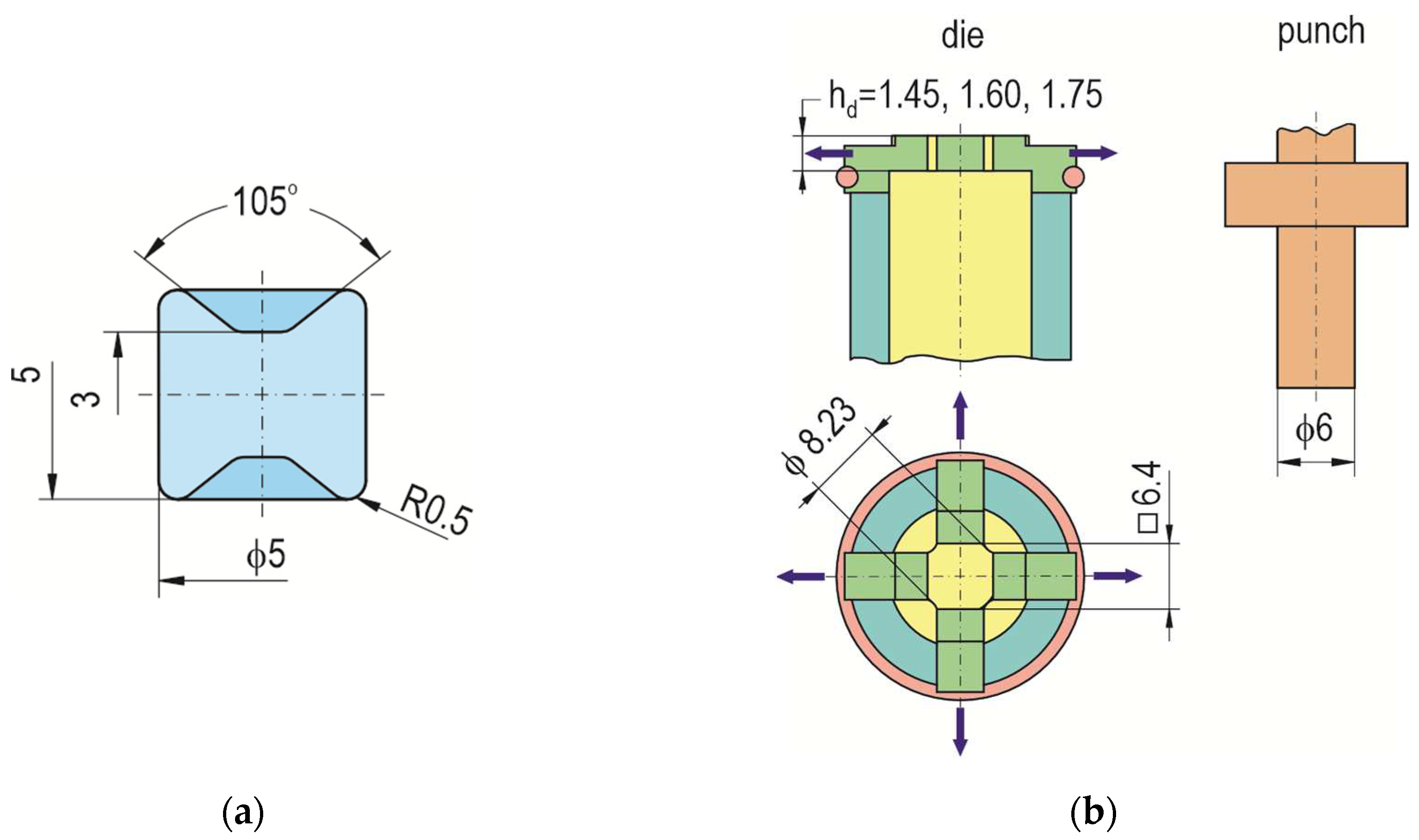
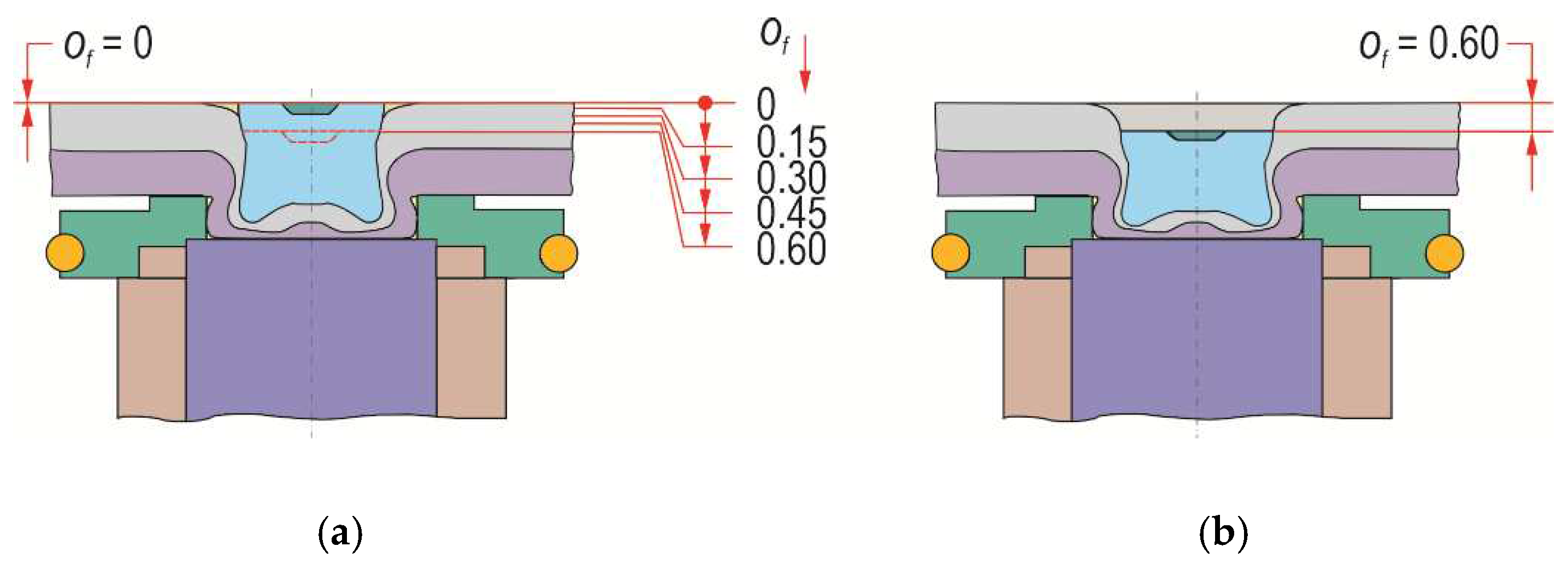
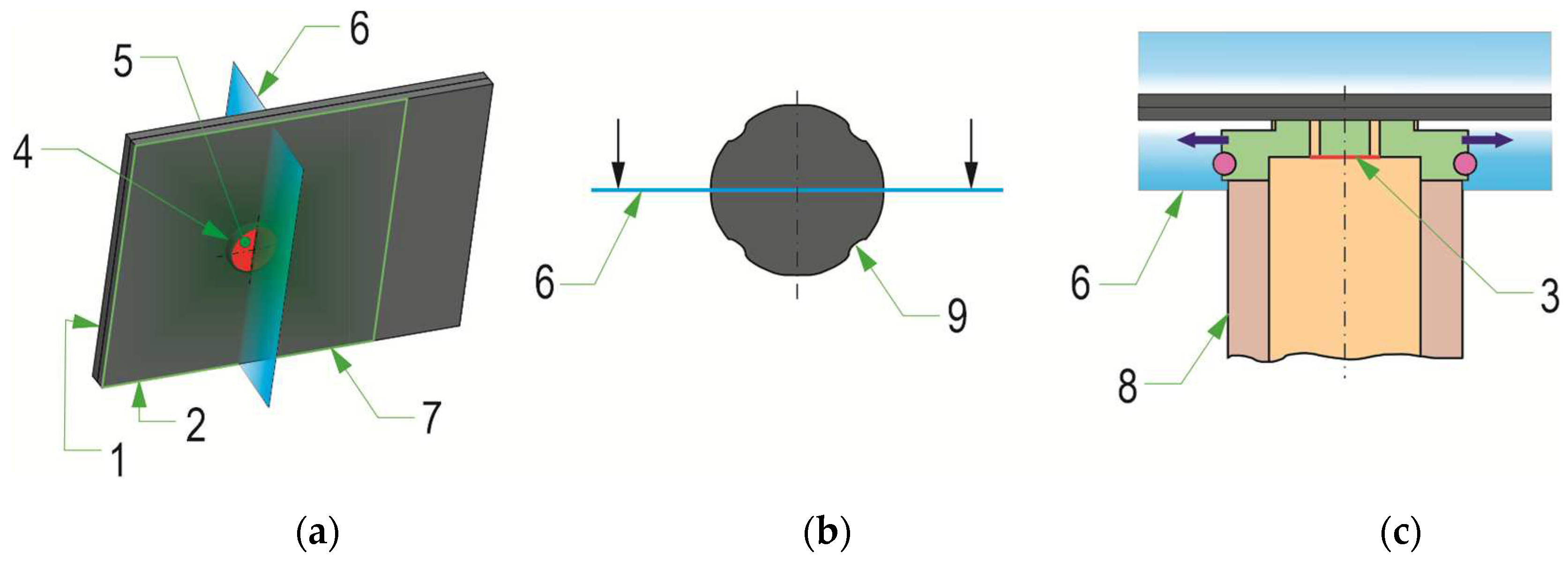
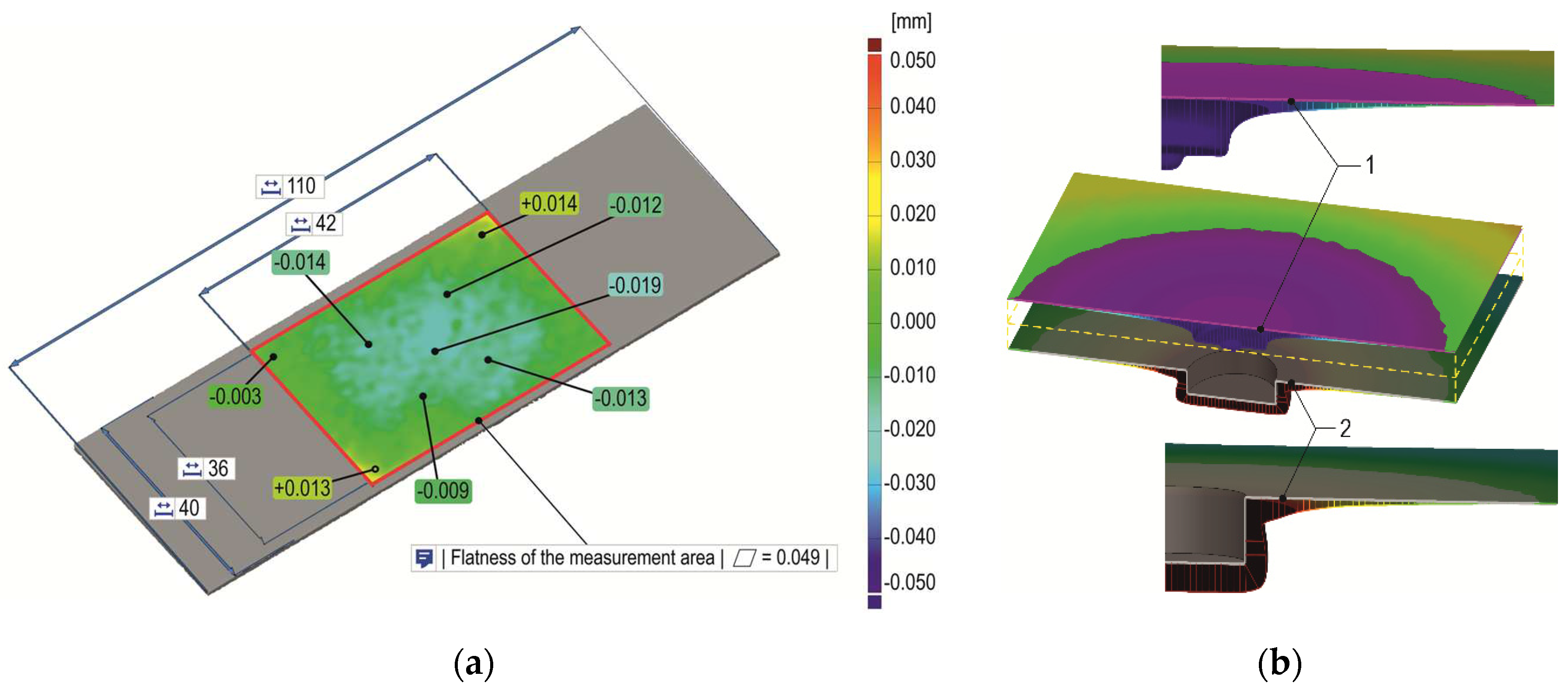
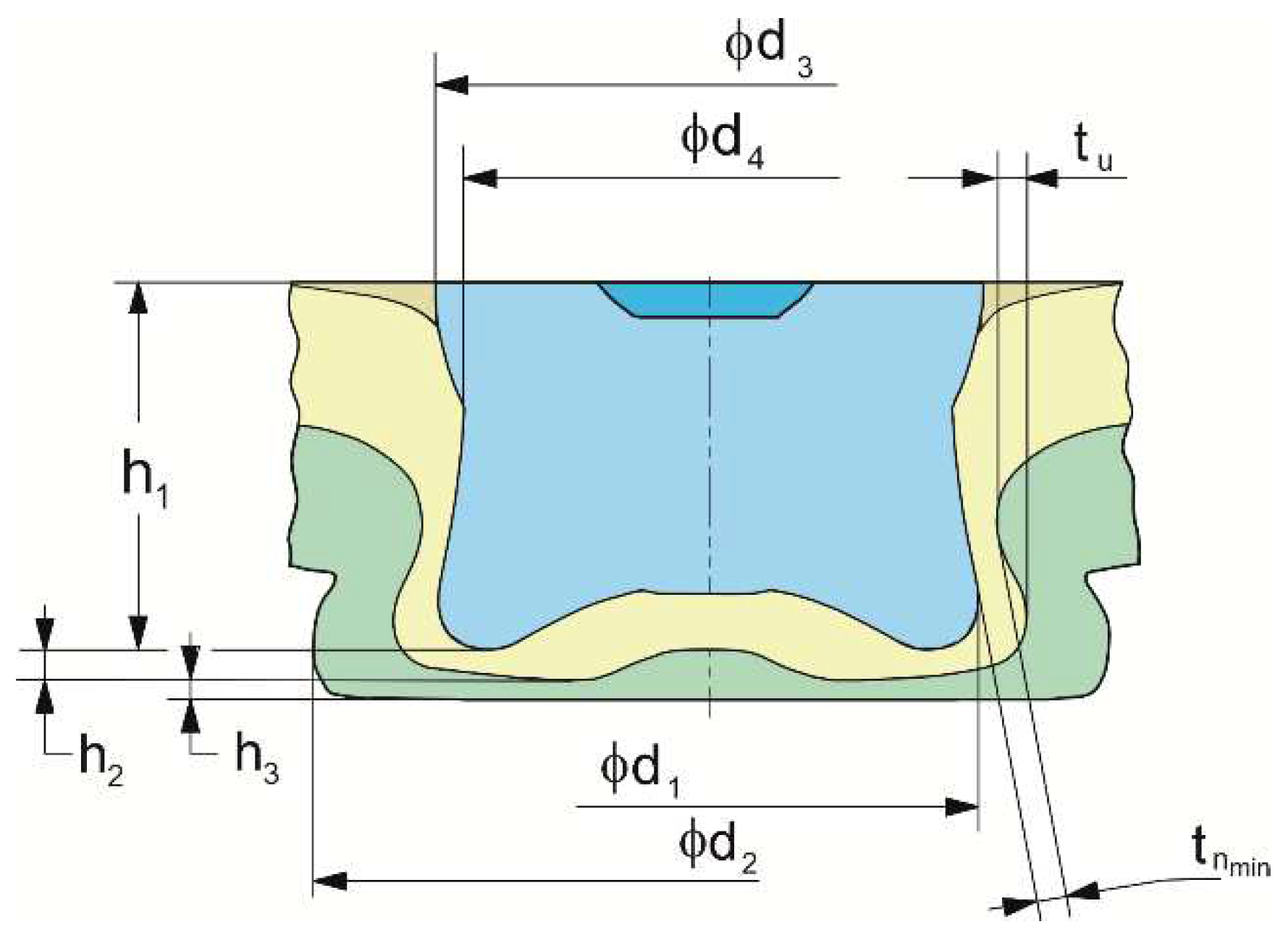
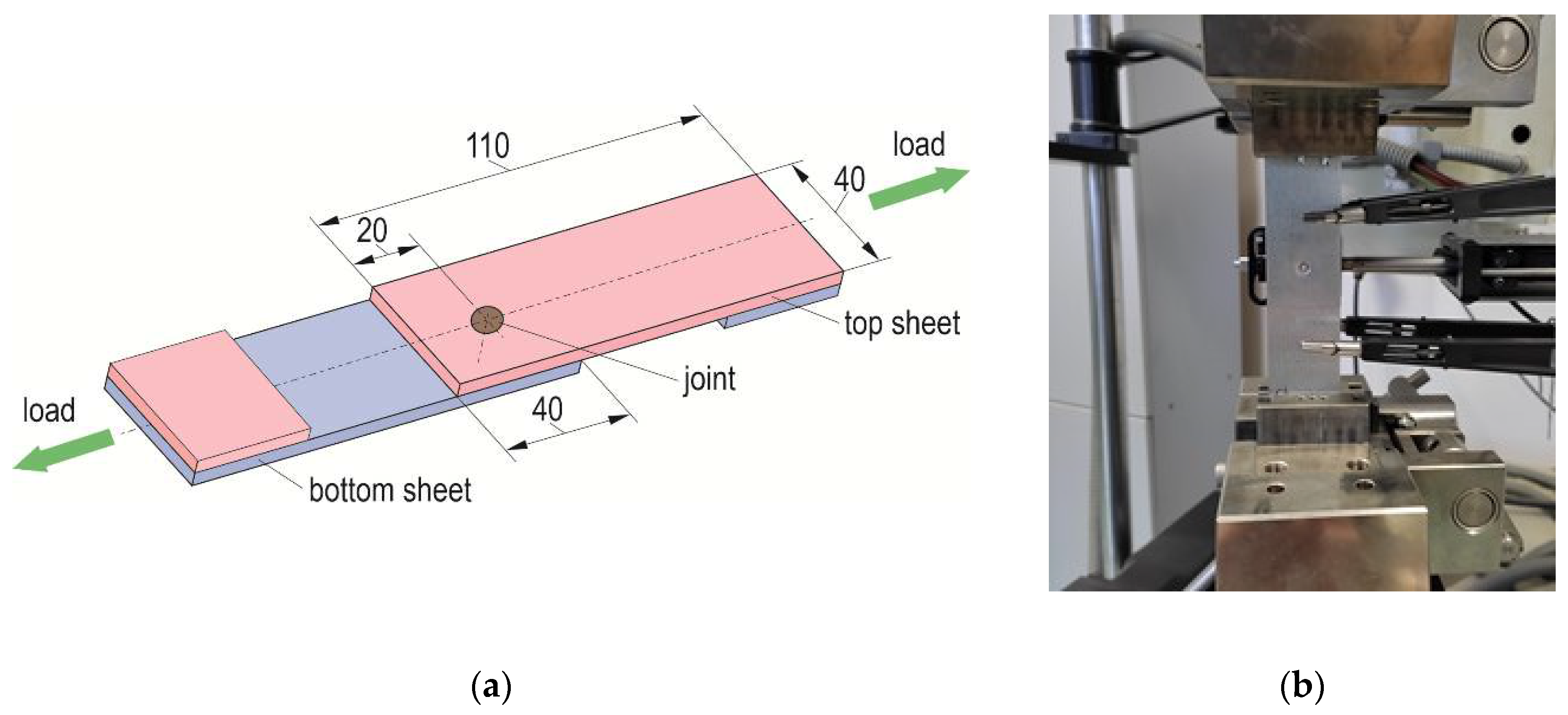
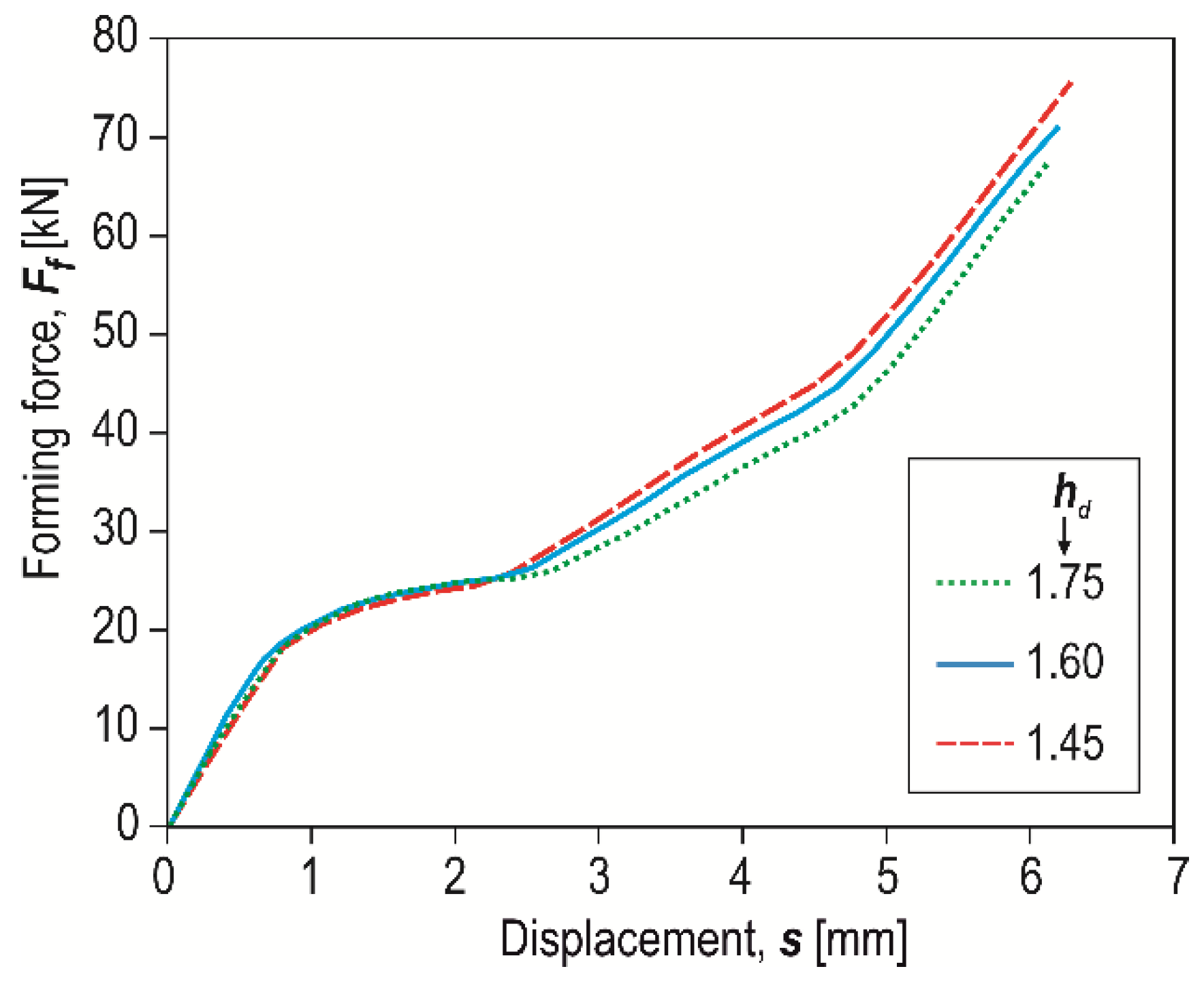
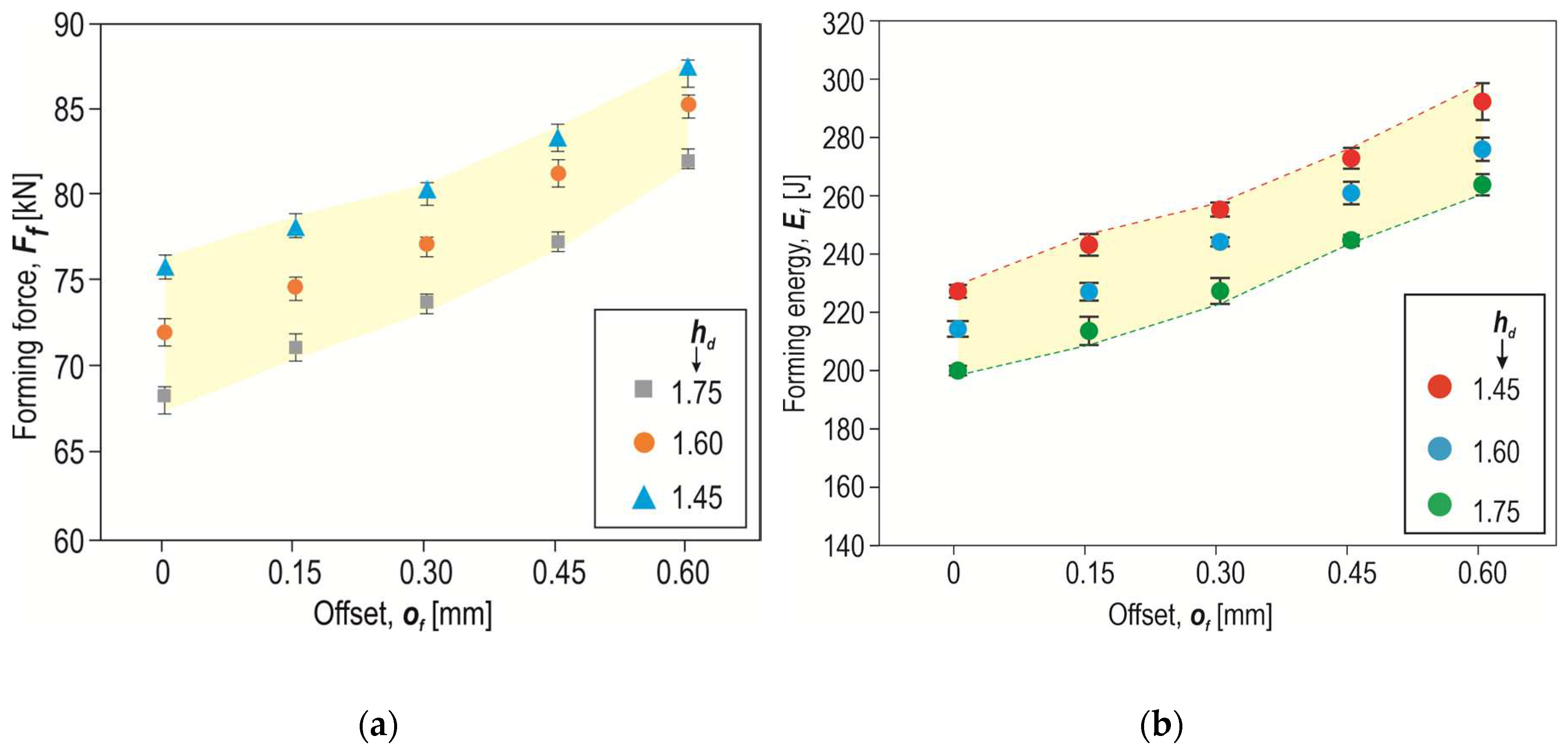
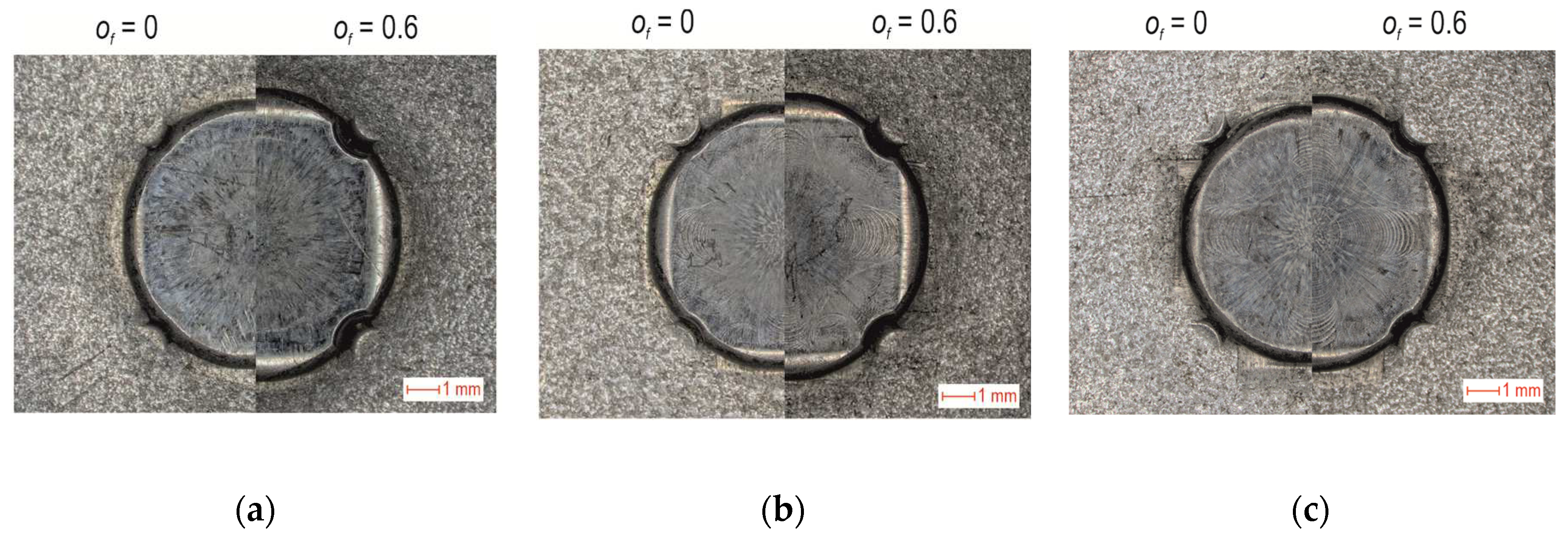
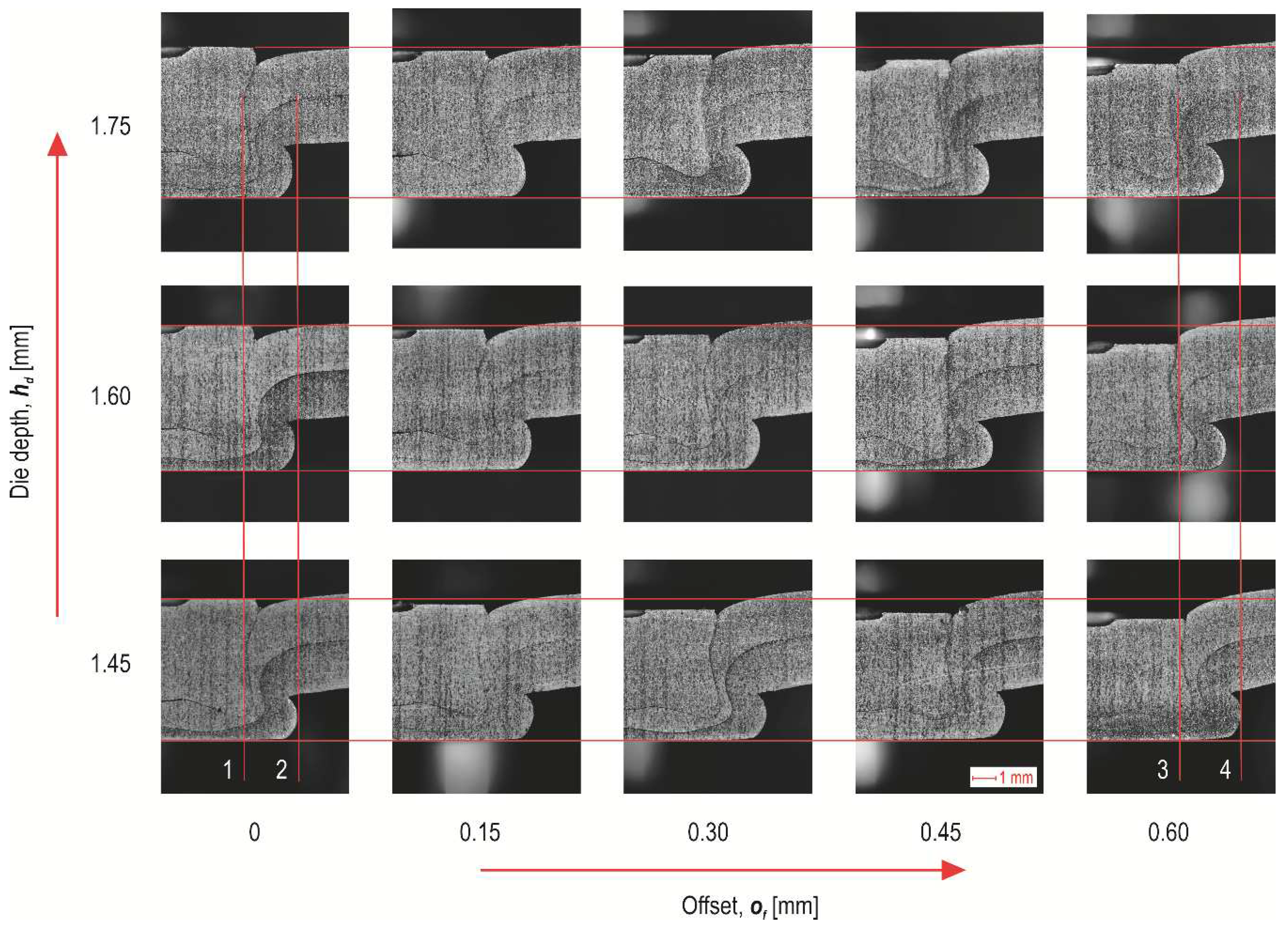
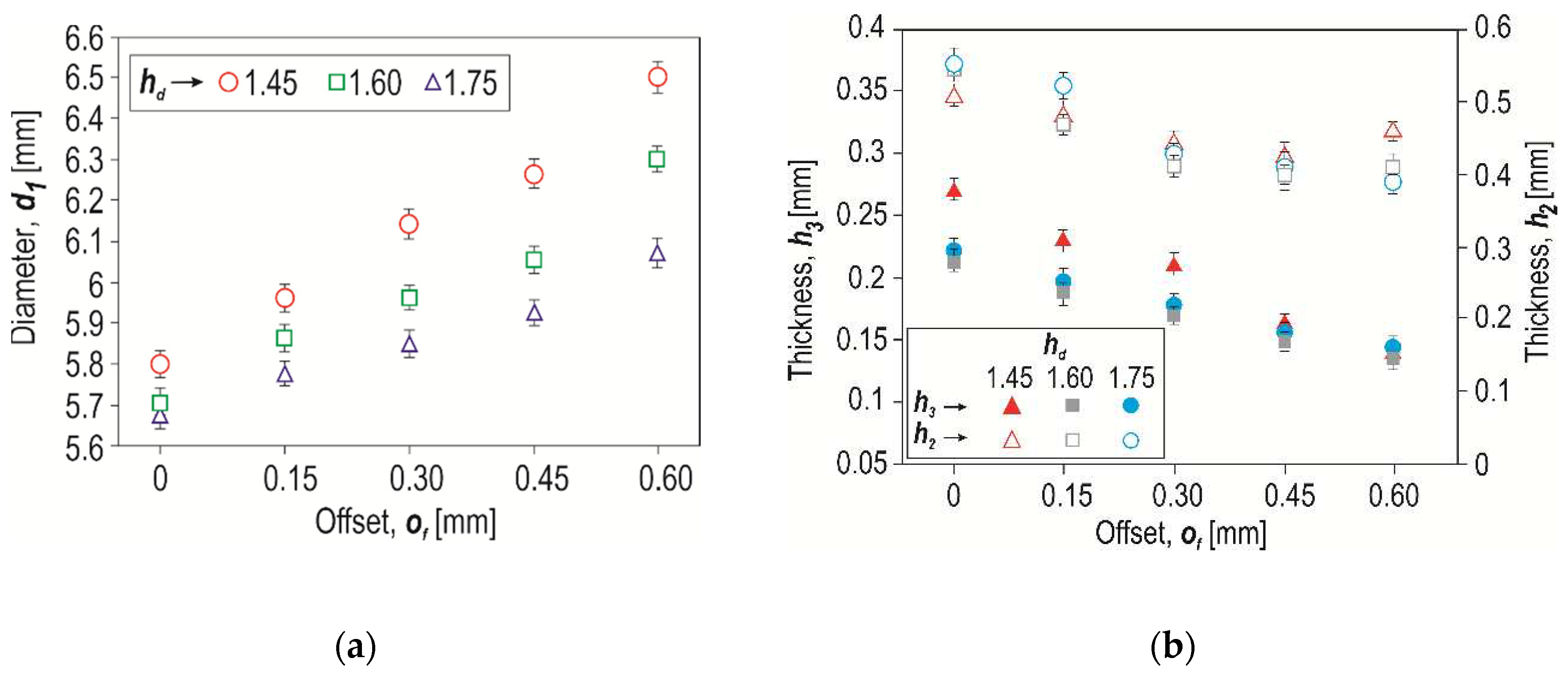
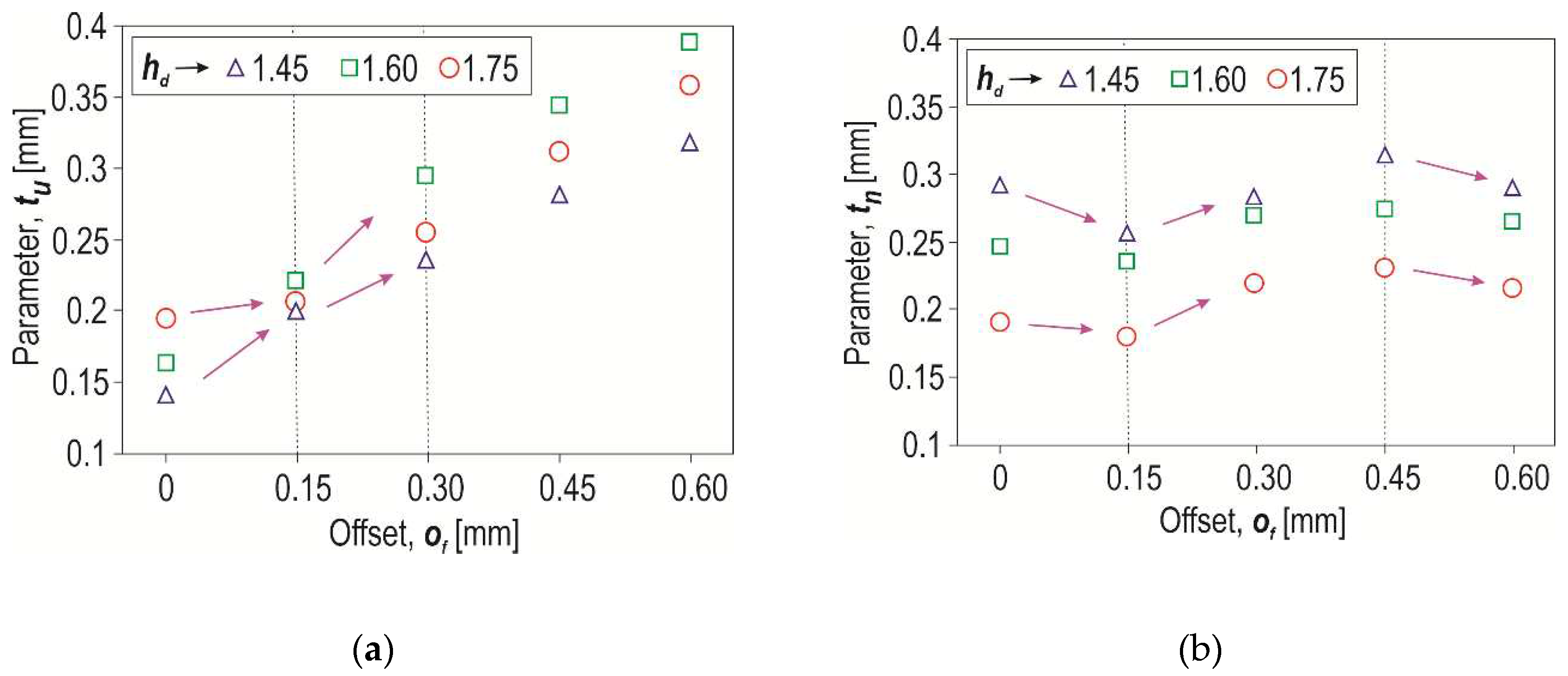
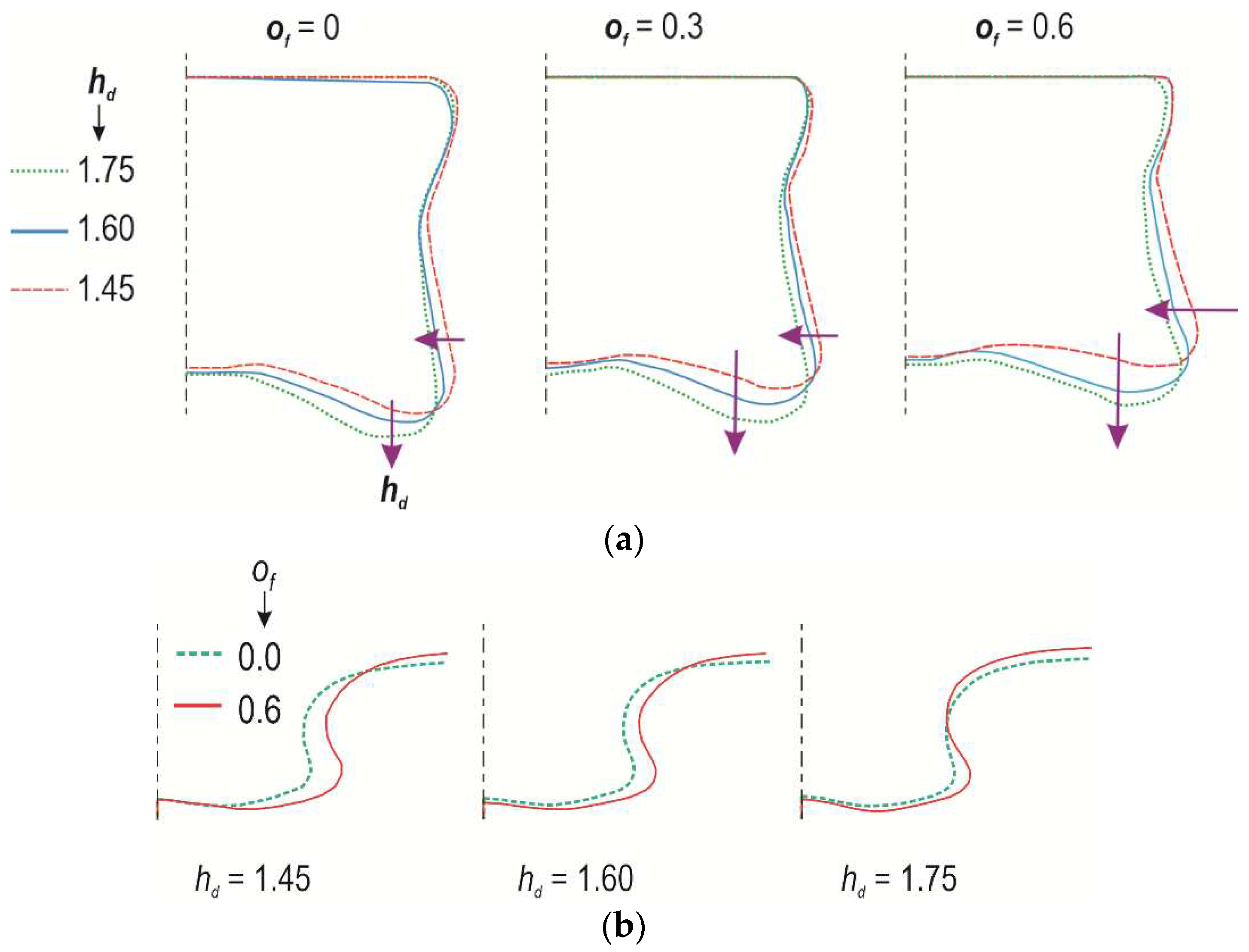
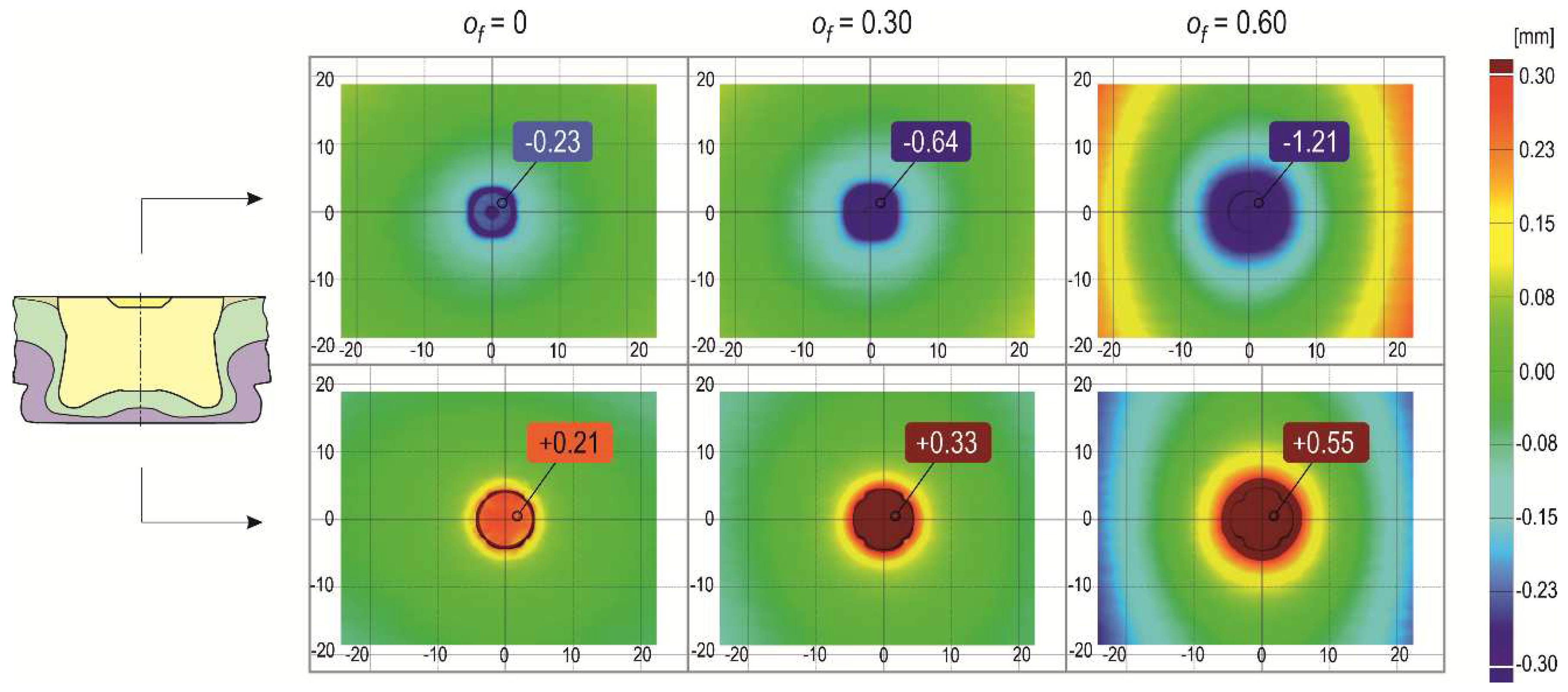
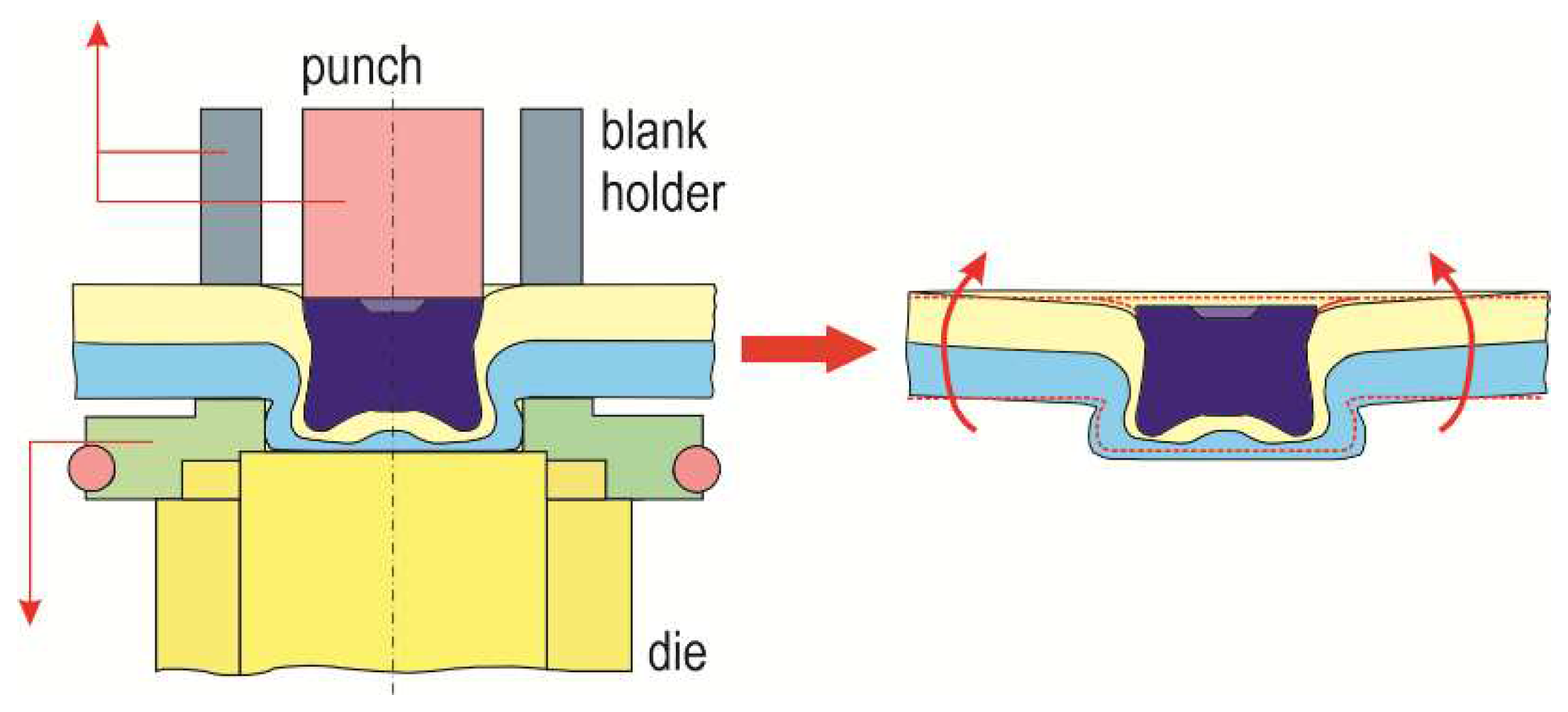
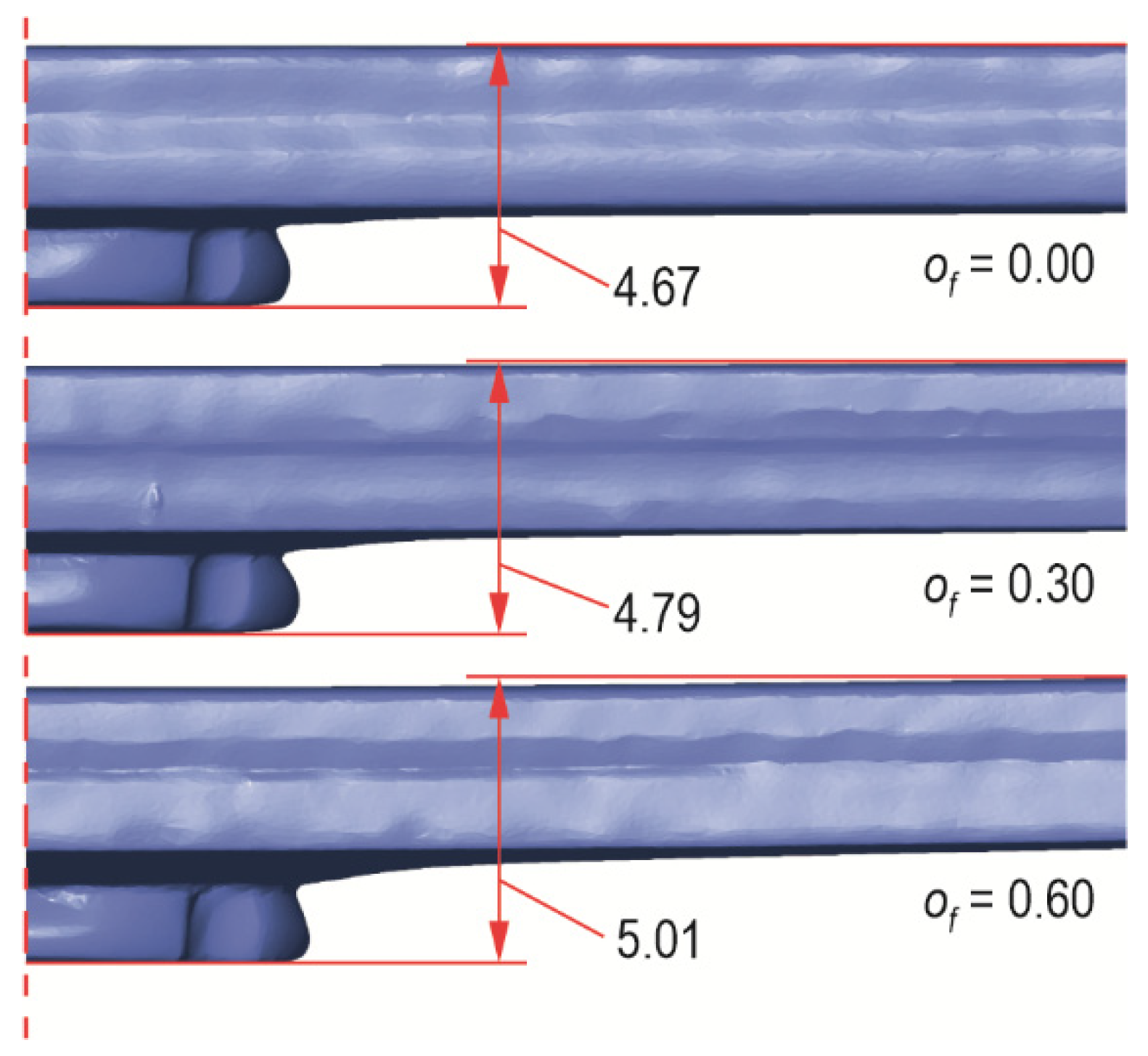
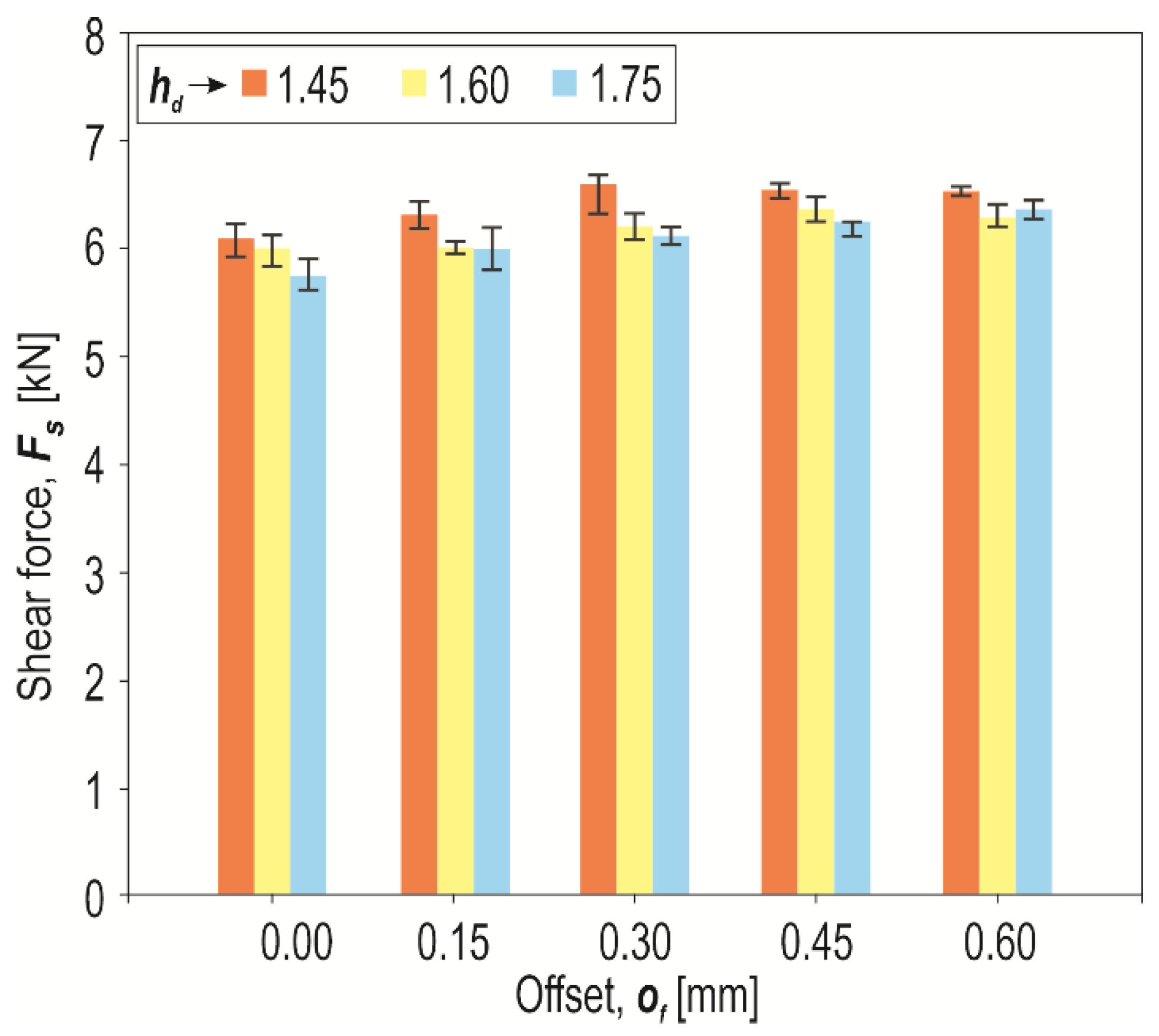
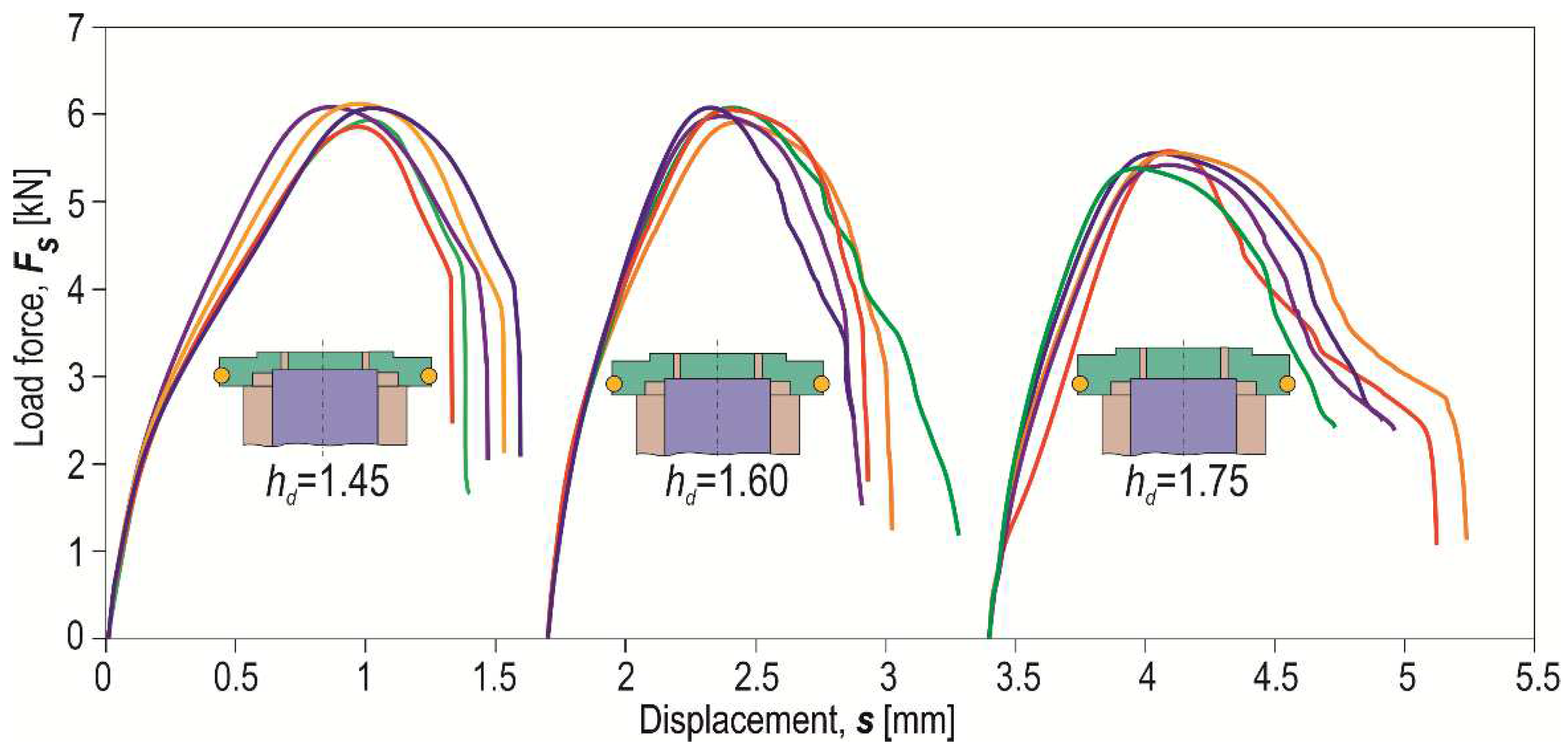

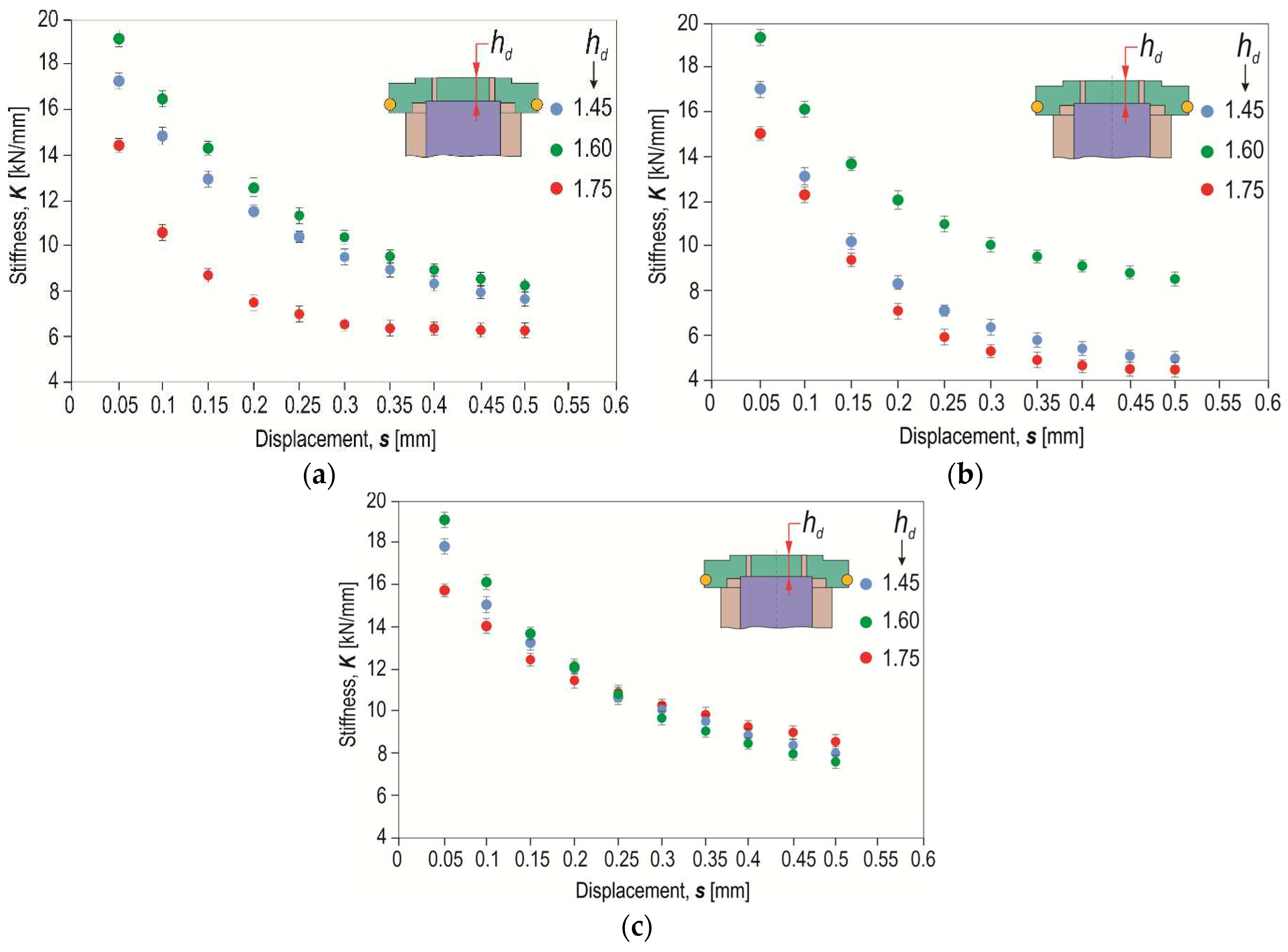


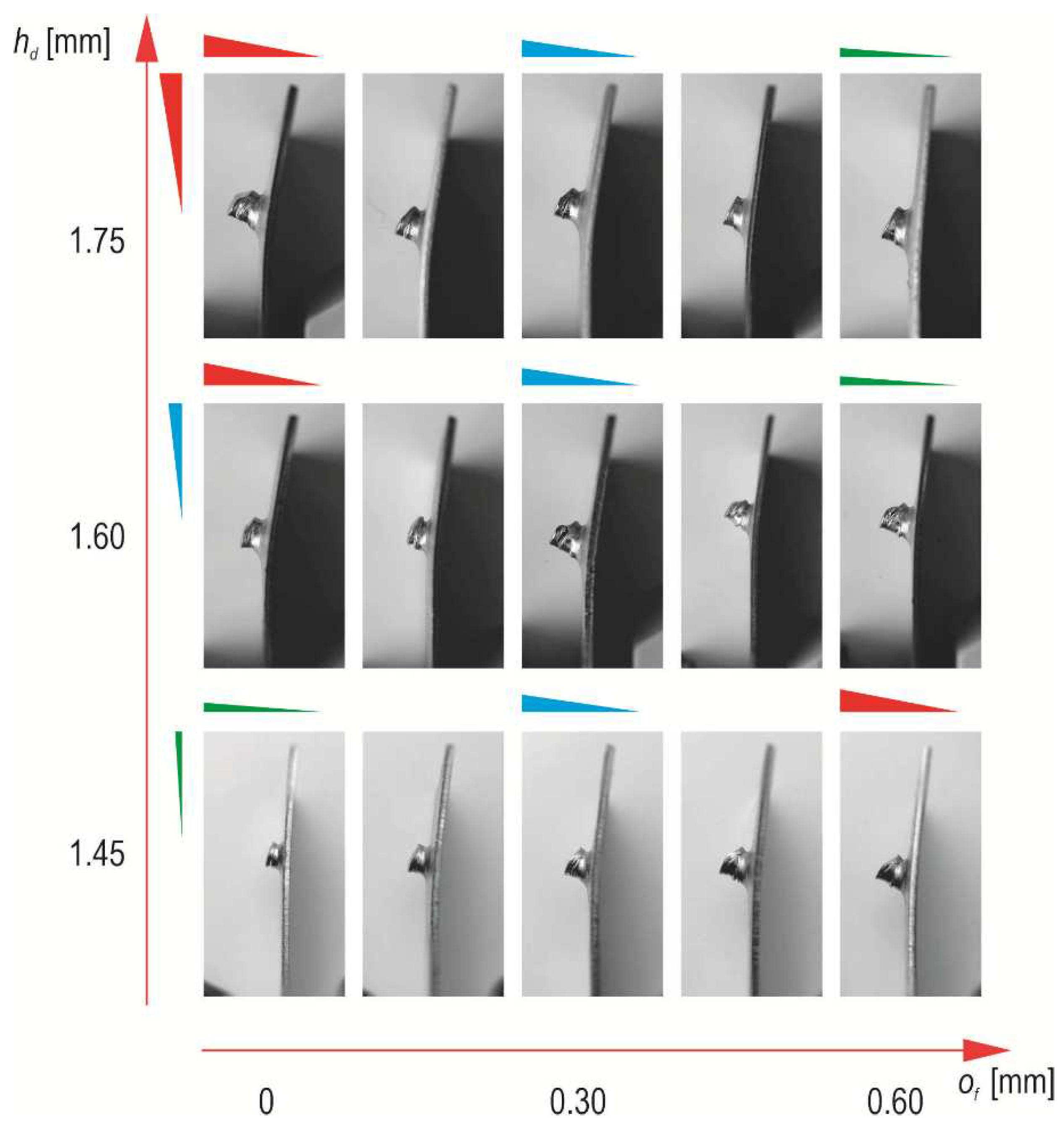
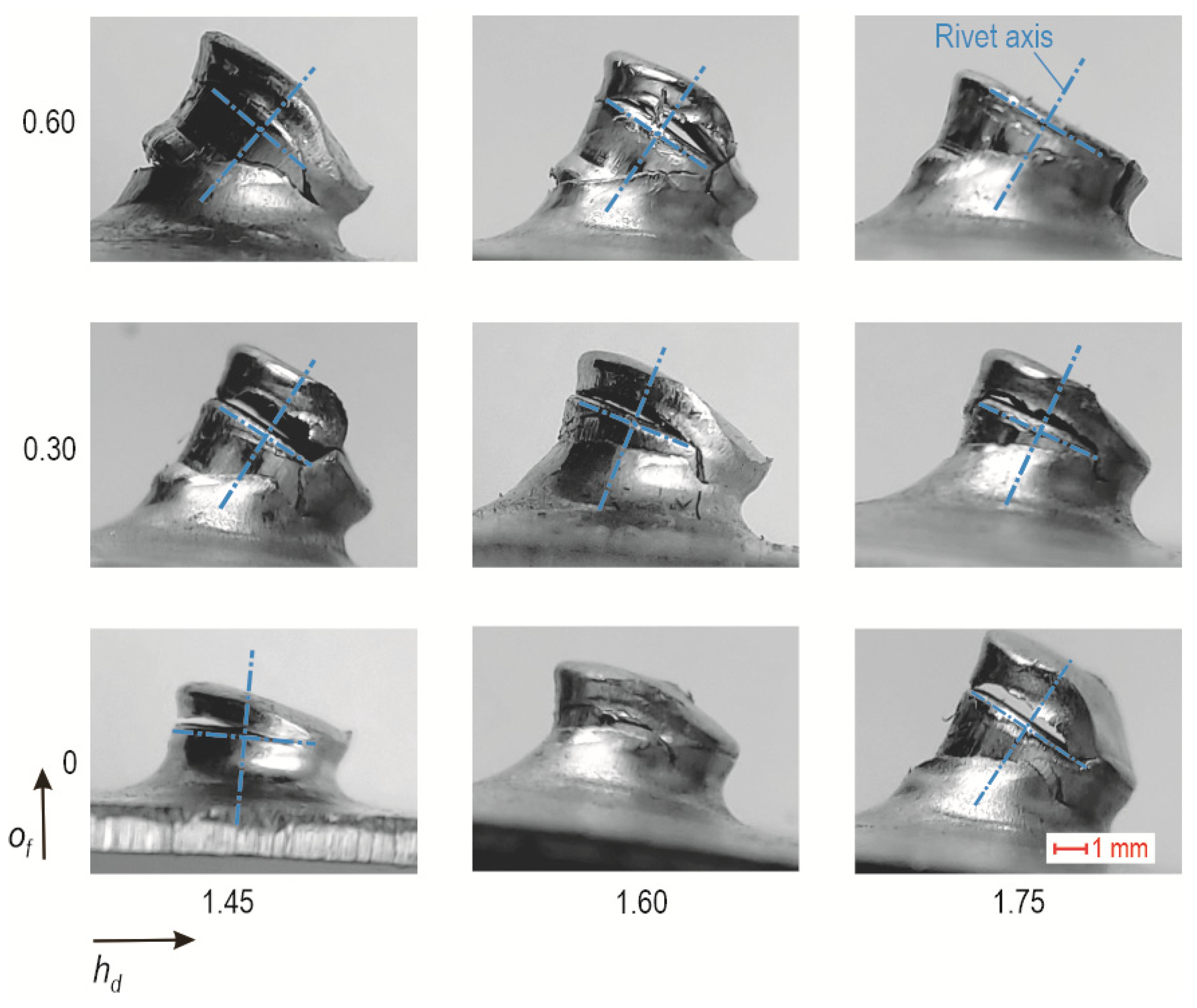
| Mn | Si | Ti | C | Nb | P | S | Al | Fe |
|---|---|---|---|---|---|---|---|---|
| 0.88 | 0.01 | 0.011 | 0.09 | 0.031 | 0.02 | 0.007 | 0.032 | remainder |
| Material designation | Surface finish +Z [g/m2] |
Young’s modulus E, [GPa] |
Poisson’s ratio | Yield strength Rp0.2 [MPa] | Tensile strength Rm, [MPa] |
Elongation after fracture A80, [%] |
Strength coefficient K, [MPa] |
Strain hardening exponent n, [-] |
|---|---|---|---|---|---|---|---|---|
| HX340 | zinc layer quality 100 | 188 | 0.29 | 365 | 463 | 29 | 807 | 0.16 |
| Offset dimension of [mm] | Die depth hd [mm] | ||
| 1.45 | 1.60 | 1.75 | |
| 0 | I-00 | II-00 | III-00 |
| 0.15 | I-15 | II-15 | III-15 |
| 0.30 | I-30 | II-30 | III-30 |
| 0.45 | I-45 | II-45 | III-45 |
| 0.60 | I-60 | II-60 | III-60 |
Disclaimer/Publisher’s Note: The statements, opinions and data contained in all publications are solely those of the individual author(s) and contributor(s) and not of MDPI and/or the editor(s). MDPI and/or the editor(s) disclaim responsibility for any injury to people or property resulting from any ideas, methods, instructions or products referred to in the content. |
© 2024 by the authors. Licensee MDPI, Basel, Switzerland. This article is an open access article distributed under the terms and conditions of the Creative Commons Attribution (CC BY) license (http://creativecommons.org/licenses/by/4.0/).





